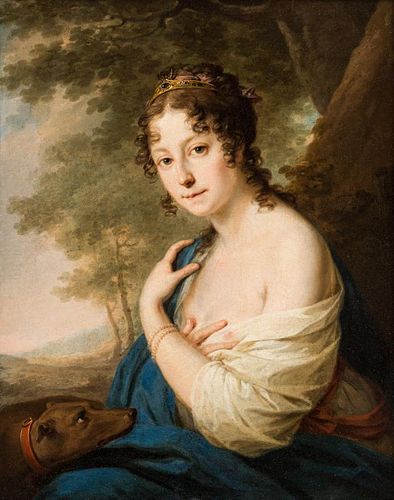ATTRIBUTED TO VLADIMIR LUKICH BOROVIKOVSKY (RUSSIAN 1757-1825)
Lot 56
About Seller
Shapiro Auctions
566 East Boston Post Road
Mamaroneck, NY 10543
United States
Our auctions feature an impressive selection of fine art, decorative art, rare books, icons, militaria, and other objects from antiquity to the present. Shapiro Auctions advertises globally and has clients all over the world, while providing a rare combination of personal service and the ability to ...Read more
Estimate:
$10,000 - $15,000
Absentee vs Live bid
Two ways to bid:
- Leave a max absentee bid and the platform will bid on your behalf up to your maximum bid during the live auction.
- Bid live during the auction and your bids will be submitted real-time to the auctioneer.
Bid Increments
| Price | Bid Increment |
|---|---|
| $0 | $25 |
| $500 | $50 |
| $1,000 | $100 |
| $2,000 | $250 |
| $5,000 | $500 |
| $10,000 | $1,000 |
| $20,000 | $2,500 |
| $50,000 | $5,000 |
| $100,000 | $10,000 |
| $200,000 | $25,000 |
About Auction
By Shapiro Auctions
Mar 18, 2017 - Mar 19, 2017
Set Reminder
2017-03-18 10:00:00
2017-03-19 10:00:00
America/New_York
Bidsquare
Bidsquare : MARCH FINE ART AND ANTIQUE AUCTION
https://www.bidsquare.com/auctions/shapiro/march-fine-art-and-antique-auction-2181
Shapiro Auctions info@shapiroauctions.com
Shapiro Auctions info@shapiroauctions.com
- Lot Description
ATTRIBUTED TO VLADIMIR LUKICH BOROVIKOVSKY (RUSSIAN 1757-1825)
Diana, based on the same composition of the goddess by Borovikovsky`s teacher, Johann Baptist Lampi,
oil on canvas
47.5 x 38 cm. (18 5/8 x 15 in.)
LITERATURE
The nearly identical version of the work by Johann Baptist Lampi is illustrated in "Un ritrattista nell`Europa dell corti" by Fernando Mazzocca, Roberto Pancheri and Alessandro Casagrande, Giovanni Battista Lampi 1751 – 1830, (Trento 2001), p. 232, n. 31
Please see Lot Notes below
LOT NOTES
Vladimir Borovikovsky received his earliest art instruction from his father, a limner icon painter, before catching the eye of Empress Catherine II and being engaged by the Empress as a court painter and student under Johann Baptist Lampi. It appears that while Borovikovsky was still Lampi`s student that he painted the figure of Diana forming the present lot.
Borovikovsky met the Empress while she was visiting the newly conquered Crimea and staying with Borovikovsky`s friend, Vasyl Kapnist, the Marshal of Nobility of the Kiev Gubernia. To please the Empress, Kapnist commissioned Borovikovsky to paint pair of allegorical works featuring the monarch for her chamber. The paintings had left a great impression on Catherine, and she requested that the artist move to St. Petersburg. Borovikovsky accepted the offer and after establishing himself in the capital in 1787, made the city his permanent residence. Although still a young man by modern standards, at thirty years old Borovikovsky was beyond the acceptable age range for formal academy training, and was set up to study privately under Johann Baptist Lampi in 1792, one of the most fashionable portrait painters of the day.
Lampi had exerted an unquestionable influence over the development of Borovikovsky`s style, particularly noticeable in the young artist`s soft palette and compositional devices. It was common practice of the day for students to copy the works of their masters, and given the existence of a strikingly similar work to the present lot by Lampi (now in the Museo Castello del Buonconsiglio in Trento, Italy) it appears likely that the work by Lampi served as a basis for this painting of Diana. The authors of the monograph Giovanni Battista Lampi 1751 - 1830 believe Lampi completed his painting of the goddess (pictured here in the ``additional images``) somewhere between 1789 and 1791, shortly before he took on Borovikovsky as a pupil, making this work a prime candidate for study and copying by the aspiring artist.
Although the pose and subject of the two paintings is nearly identical, one cannot help but notice where Borovikovsky deviated from his master`s approach and imbued the subject with his own vision. Stronger, cleaner lines replace his master`s sfumato and cooler mother-of-pearl shade pastels replace the warmer hues. The beauty of the face and figure remain paramount, however, with the folds of the robes, the position of the hands, and other scenic devices primarily used to enhance the allure of the subject, as would become a hallmark of Borovikovsky`s oeuvre. Although unsigned, given the work`s close connection to the painting of Diana by Johann Baptist Lampi, created shortly before Borovikovsky was taken on as a student, and given the slight but notable variations between the two works clearly done by different masters, it is quite likely that the present lot is an early work by Vladimir Borovikovsky, while the artists was still on the cusp of greatness. - Buyer's Premium



 EUR
EUR CAD
CAD AUD
AUD GBP
GBP MXN
MXN HKD
HKD CNY
CNY MYR
MYR SEK
SEK SGD
SGD CHF
CHF THB
THB






